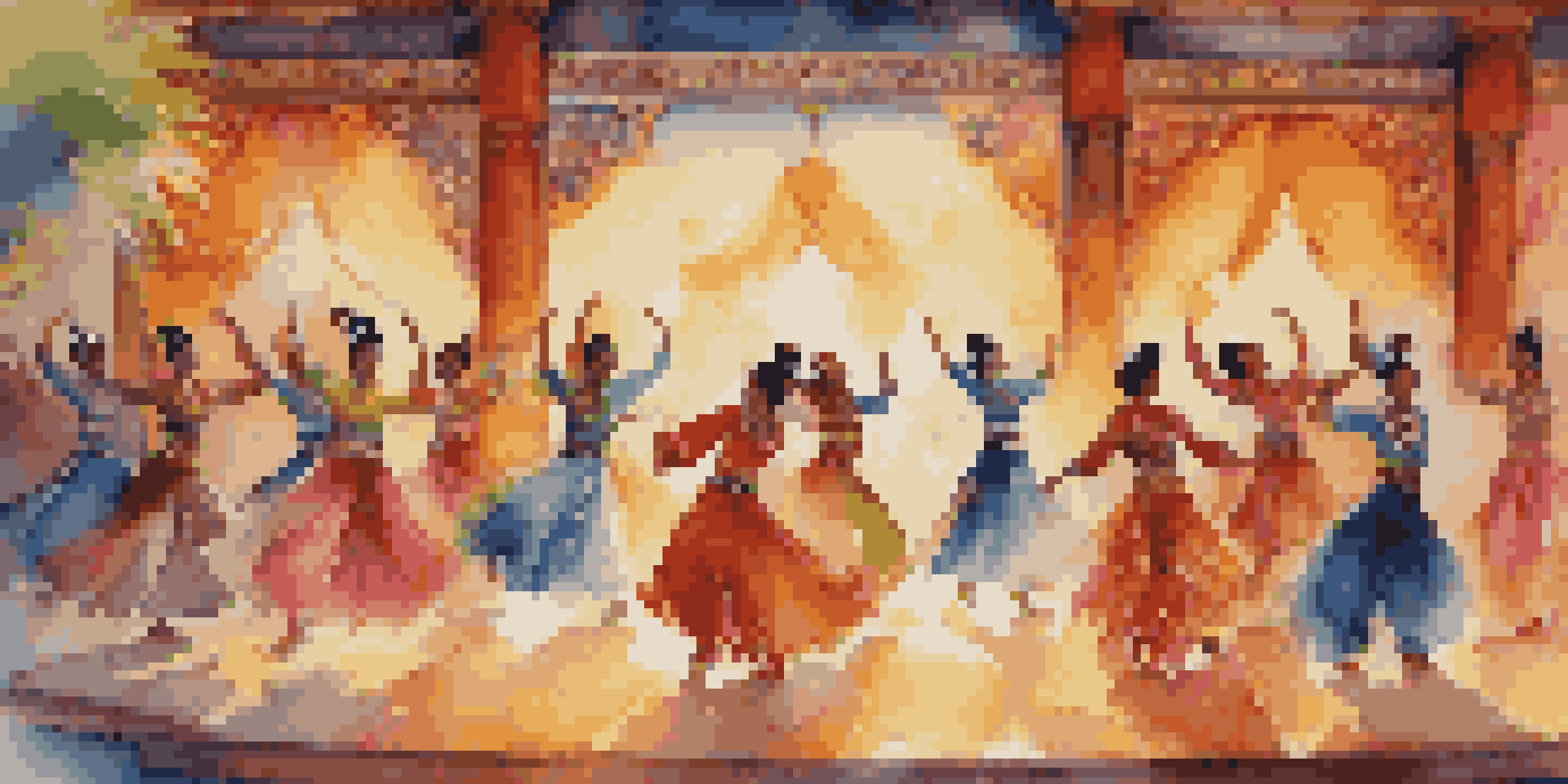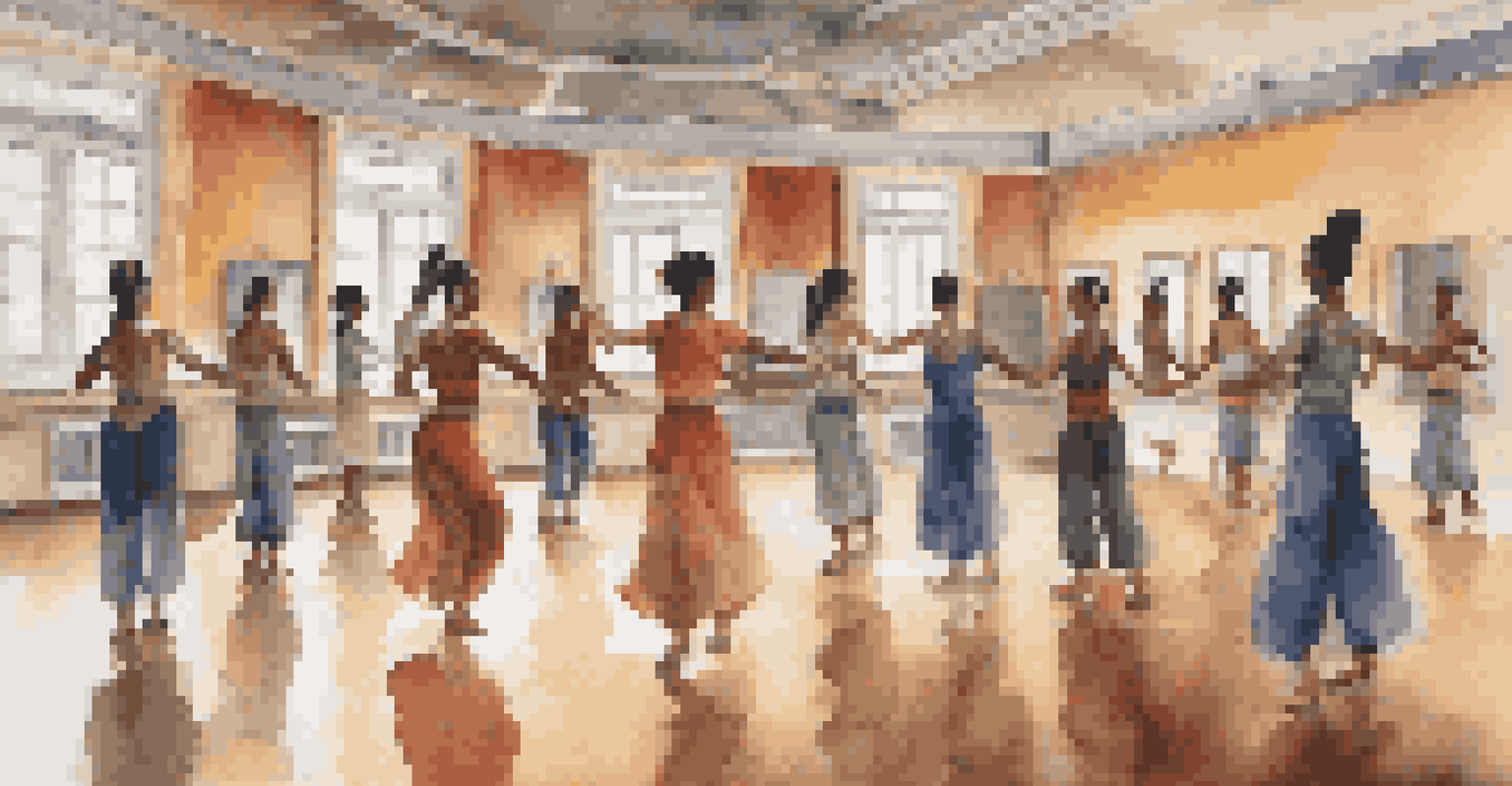Understanding Identity and Cultural Appropriation in Dance

The Importance of Identity in Dance
Identity in dance is crucial as it reflects who we are and where we come from. Each dance form carries the history and culture of its people, often telling stories that resonate deeply with the community. For instance, traditional dances like the Hawaiian hula convey spiritual significance and connect dancers to their ancestry. Understanding this connection enriches our appreciation of dance, making it more than just movement but a form of expression.
Dance is the hidden language of the soul.
When dancers perform, they are not just showcasing steps; they are embodying their identity and heritage. This is why dance can serve as a powerful medium for storytelling, connecting generations and bridging cultural gaps. For example, a ballet performance can reflect European history while a hip-hop piece might express urban struggles. Recognizing these elements helps us see dance as a reflection of diverse identities.
Moreover, identity in dance also encompasses personal experiences and emotions that dancers bring to their performances. When a dancer infuses their unique background into their art, it creates a richer experience for the audience. Therefore, understanding identity in dance is not just about cultural representation; it’s about honoring individual stories that contribute to the larger tapestry of human expression.
Defining Cultural Appropriation in Dance
Cultural appropriation refers to the unacknowledged or inappropriate adoption of elements from one culture by members of another culture. In dance, this can manifest when performers adopt styles or movements without understanding their significance or context. For example, a contemporary dance piece might incorporate traditional African dance moves, but if done without respect or understanding, it can dilute the original meaning and impact.

This concept can be particularly sensitive in dance, where movements are often laden with cultural meaning. When artists borrow from cultures that are not their own, it raises questions about ownership, respect, and authenticity. A clear example can be seen in the commercialization of Native American dances, which can perpetuate stereotypes rather than honor the culture's significance.
Identity Shapes Dance Expression
Dance reflects individual and cultural identities, making it a powerful medium for storytelling and connection.
Cultural appropriation in dance not only affects the original culture but can also lead to misunderstandings among audiences. When cultural elements are presented without context, they risk being seen as mere entertainment rather than a rich part of a community's heritage. Addressing this issue requires sensitivity and a commitment to understanding the cultural significance behind the movements.
The Fine Line: Appreciation vs. Appropriation
Navigating the line between appreciation and appropriation in dance can be quite challenging. Appreciation involves a respectful engagement with a culture, often characterized by learning, collaboration, and acknowledgment of the source. For instance, a dance company that collaborates with traditional dancers to create a fusion piece can showcase appreciation by honoring the original form while innovating.
Cultural appropriation is not a new phenomenon, but it is one that deserves careful consideration and respect.
On the other hand, appropriation often stems from a lack of understanding or respect. This can occur when dancers perform styles without any connection to their origins, often leading to misrepresentation. Imagine a dance festival featuring a 'world dance' segment that showcases different styles without context; it may become a spectacle rather than a celebration of cultural diversity.
To foster genuine appreciation, it’s essential for dancers and choreographers to educate themselves about the cultures they wish to engage with. This means not just learning the steps, but also understanding the historical and social contexts behind the movements. By doing so, artists can create authentic connections that elevate their work and honor the cultures they draw inspiration from.
The Role of Education in Dance
Education plays a pivotal role in addressing issues of identity and cultural appropriation in dance. By learning about different cultures, dancers can gain a deeper understanding of the significance behind various dance forms. Workshops, classes, and discussions led by cultural experts can provide invaluable insights that inform a dancer’s practice and performance.
For example, a dance academy that incorporates cultural studies into its curriculum can prepare students to engage with diverse dance forms meaningfully. This education encourages dancers to approach their art with respect and awareness, fostering a generation of artists who value cultural integrity. It also cultivates an environment where dialogue about cultural nuances is encouraged.
Understanding Cultural Appropriation
Cultural appropriation in dance occurs when elements are adopted without respect for their origins, often leading to misrepresentation.
Moreover, educational initiatives can help raise awareness about the impact of cultural appropriation. By engaging in conversations around this topic, dancers can learn how to navigate their artistic expressions responsibly. Ultimately, education empowers dancers to celebrate diversity while being mindful of the stories they tell through their art.
The Impact of Social Media on Dance Culture
Social media has transformed the way dance is shared and experienced, offering a platform for diverse styles to reach wider audiences. However, this accessibility can also blur the lines between cultural appreciation and appropriation. Viral dance trends often take elements from various cultures without acknowledging their origins, leading to conversations about respect and ownership.
For example, TikTok has popularized many dance challenges that borrow from specific cultural movements, sometimes without proper credit. This raises questions about who gets to profit from these dances and whether the original creators receive recognition. Social media can amplify the voices of marginalized communities, but it can also perpetuate a cycle of appropriation if not approached thoughtfully.
Nevertheless, social media can also serve as a tool for education and advocacy. Dancers and cultural activists can use these platforms to raise awareness about the importance of respecting cultural origins. By sharing stories and insights, they can foster a more informed community that celebrates diversity while promoting ethical engagement with different dance forms.
Celebrating Diversity Through Collaboration
One effective way to navigate cultural appropriation in dance is through collaboration. By partnering with artists from different backgrounds, dancers can create works that honor the origins of the styles they’re incorporating. This not only respects the cultural significance but also enriches the artistic process, leading to innovative and authentic performances.
For instance, a dance project that brings together ballet dancers and traditional Indian dancers can create a fusion that celebrates both art forms. This collaboration allows for dialogue and exchange, fostering mutual respect and understanding. When artists work together, they can share not just techniques, but also the cultural stories that inspire their movements.
Collaboration Fosters Respect
Collaborating with artists from diverse backgrounds can create innovative works that honor cultural significance and promote inclusivity.
Moreover, these collaborative efforts can serve as a platform for underrepresented voices in the dance community. By showcasing diverse perspectives, artists can challenge stereotypes and promote a more inclusive narrative. Ultimately, celebrating diversity through collaboration encourages a richer dance culture that honors its roots while embracing creativity.
Moving Forward: Ethical Dance Practices
As we continue to explore identity and cultural appropriation in dance, it’s essential to adopt ethical practices. This means committing to understanding the cultural significance of the dances we engage with and recognizing the voices of those who originate them. Dancers and choreographers should strive to create work that is not only artistic but also respectful and informed.
Additionally, fostering an inclusive environment within the dance community can help promote ethical practices. This involves creating spaces where artists from diverse backgrounds feel empowered to share their stories and traditions. By encouraging dialogue and collaboration, the dance community can evolve into a more supportive and respectful space.

Ultimately, moving forward with ethical dance practices requires ongoing reflection and education. Dancers should continually assess their relationship with the cultures they engage with, ensuring that their work honors rather than exploits. By embracing this mindset, we can cultivate a dance culture that is rich in diversity, respect, and authenticity.